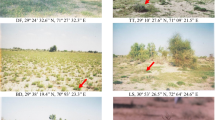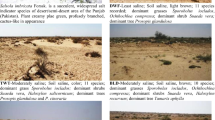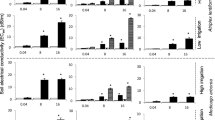Abstract
Suaeda vera is a succulent halophyte that colonizes hypersaline soils. Ecotypic variability is extremely high. Plant roots are the first line of defense and respond instantly to soil salinity. In the present study, we collected 21 ecotypes from ecologically different habitats to explore the degree of salt tolerance, which can be proved extremely beneficial. This study was conducted to explore the alterations in root morphology, anatomy, and physiology likely to be associated with salinity tolerance. A mechanistic insight was developed to evaluate interaction of soil properties with root modifications toward enhancing survival and development under hypersaline conditions. Increase in salinity was associated with longer root, and, high root fresh and dry biomass. The highest shoot biomass and water contents were found in populations from highly saline habitat (ECe 36.33 to 55.51 dS m−1). Discrete anatomical variations such as reduced parenchymatous region thickness, increased sclerification in the stelar region, and broad metaxylem vessels were recorded at high salinities. The reduced or disintegrated primary tissues (epidermis, endodermis, and cortex) were found to be the main reason that supported the absorption of nutrient from soil-root and root to shoot. The salinity tolerance mechanism relied on root structural modification. The dominant traits enabling salinity tolerance of this species were much larger and fast-conducting metaxylem vessels that enhanced compartmentalization aboveground plant organs. Extensive sclerification in the stelar region involved in water conservation and mechanical strength of roots hence enabled this species to colonize hot arid and saline conditions.










Similar content being viewed by others
Data Availability
1. The voucher specimens used for plant identification are deposited to the herbarium facility of the Department of Botany, University of Agriculture, Faisalabad, and are available for verification on request.
2. Anatomical slides, photographs, and raw data calculated from these photographs are available with the primary author and can be requested if needed.
Code Availability
R codes and modeling details are available with author(s) listed as bio-statisticians under author’s contribution section of Declarations and can be requested if needed to reproduce the data visualization or other results.
Abbreviations
- CC :
-
Chiniot Chenab River
- CH :
-
Cholistan-Qila Nawab Din
- CK :
-
Chowk Azim
- CT :
-
Control
- DF :
-
Derwar Fort
- ES :
-
Express Way Faisalabad to Sahianwala
- GC :
-
Gutwala Canal
- KS :
-
Kohe-e-Suleman Foothills
- LS :
-
Lillah Salt Range
- PP :
-
Peerowal Plantation
- PS :
-
Pati Sir Lake
- RD :
-
Rajanpur Desert
- RP :
-
Rahim Yar Khan
- SH :
-
Sangla Hill
- SK :
-
Shorkot
- SM :
-
Sahianwala salt marsh
- SS :
-
Sakhi Sarwar
- SW :
-
Sahianwala waterlogged area
- TB :
-
Taunsa Barrage
- UC :
-
Ucchali
- WS :
-
Warcha Salt Mines
- CT :
-
Control
- Ca :
-
Soil Ca2+
- Cl :
-
Cl–
- ECe :
-
Electrical conductivity
- K :
-
K+
- Na :
-
Na+
- NO :
-
NO3
- OM :
-
Organic matter
- pH :
-
Soil pH
- PO :
-
PO43−
- SP :
-
Soil saturation percentage
- RDW :
-
Root dry weight
- RFW :
-
Root fresh weight
- RL :
-
Root length
- RWC :
-
Root water content
- SDW :
-
Shoot dry weight
- SFW :
-
Shoot fresh weight
- SL :
-
Shoot length
- SWC :
-
Shoot water content
- R. Ca :
-
Root Ca2+
- R. Cl :
-
Root Cl−
- R. K :
-
Root K+
- R. Na :
-
Root Na+
- S. Na :
-
Shoot Na+
- S. Ca :
-
Shoot Ca2+
- S. Cl :
-
Shoot Cl−
- S. K :
-
Shoot K+
- RtA :
-
Root area
- RcT :
-
Root cortical thickness
- RcA :
-
Root cortical cell area
- RmA :
-
Root metaxylem area
- RpA :
-
Root phloem area
- RsT :
-
Root sclerenchyma thickness
- RsA :
-
Root stelar region area
References
Acosta-Motos, J. R., Ortuno, M. F., Vicente, A. B., Vivancos, P. D., Blanco, M. J. S., & Hernandez, J. A. (2017). Plant responses to salt stress: Adaptive mechanisms. Agronomy, 7(1), 18.
Adams, E., & Shin, R. (2014). Transport, signaling, and homeostasis of potassium and sodium in plants. Journal of Integrative Plant Biology, 56(3), 231–249.
Akhtar, N., Aqeel, M., Hameed, M., Alhaithloul, H. A. S., Alghanem, M., Shahnaz, M. M., Hashem, A., Almari, S., Khalid, N., Alzoubi, O. M., Iqbal, M. F., Masood, T., & Noman, A. (2021). Foliar architecture and physio-biochemical plasticity determines survival of Typha domingensis Pers. Ecotypes in nickel and salt affected soil. Environmental Pollution, 286, 117316.
Akhzari, D., Sepehry, A., Pessarakli, M., & Barani, H. (2012). Studying the effects of salinity stress on the growth of various halophytic plant species (Agropyron elongatum, Kochia prostrata and Puccinellia distans). World Applied Science Journal, 16(7), 998–1003.
Arif, M. R., Islam, M. T., & Robin, A. (2019). Salinity stress alters root morphology and root hair traits in Brassica napus. Plants (Basel), 8(7), 192.
Asghar, N., Hameed, M., & Ahmad, M. S. A. (2022). Ion homeostasis in differently adapted populations of Suaeda vera Forssk. ex J.F. Gmel. for phytoremediation of hypersaline soils. International Journal of Phytoremediation. https://doi.org/10.1080/15226514.2022.2056134
Barberon, M., & Geldner, N. (2014). Transport of nutrients: The plant root as a polarized pithelium. Plant Physiology, 166(2), 528–537.
Batool, R., Hameed, M., Ashraf, M., Fatima, S., Nawaz, T., & Ahmad, M. S. A. (2014). Structural and functional response to metal toxicity in aquatic Cyperus alopecuroides Rottb. Limnologica, 48, 46–56.
Bayat, F., Shiran, B., & Belyaev, D. V. (2011). Overexpression of HvNHX2, a vacuolar Na/H antiporter gene from barley, improves salt tolerance in Arabidopsis thaliana. Australian Journal of Crop Science, 5(4), 428–432.
Bazihizina, N., Colmer, T. D., & Barrett-Lennard, E. G. (2009). Response to non-uniform salinity in the root zone of the halophyte Atriplex nummularia: Growth, photosynthesis, water relations and tissue ion concentrations. Annals of Botany, 104(4), 737–745.
Benito, B., Haro, R., Amtmann, A., Cuin, T. A., & Dreyer, I. (2014). The twins K+ and Na+ in plants. Journal of Plant Physiology, 171(9), 723–731.
Chapman, V. J. (1942). The new perspective in the halophytes. The Quarterly Review of Biology, 17(4), 291–311.
Chaudhary, D. R., Kim, J., & Kang, H. (2018). Influences of different halophyte vegetation on soil microbial community at temperate salt marsh. Microbial Ecology, 75(3), 729–738.
Chen, M., Yang, Z., Liu, J., Zhu, T., Wei, X., Fan, H., & Wang, W. (2018). Adaptation mechanism of salt excluders under saline conditions and its applications. International Journal of Molecular Science, 19(11), 3668.
Eisa, S., Hussin, S., Geissler, N., & Koryo, H. W. (2012). Effect of NaCl salinity on water relations, photosynthesis and chemical composition of quinoa (Chenopodium quinoa Willd.) as a potential cash crop halophyte. Australian Journal of Crop Science, 6(2), 357–368.
Fatima, S., Hameed, M., Naz, N., Shah, S. M. R., Naseer, M., Aqeel, S., Ashraf, M., Ahmad, F., & Ahmad, I. (2021). Survival strategies in khavi grass [Cymbopogon jwarancusa (Jones) Schult.] colonizing hot hypersaline and arid environments. Water Air and Soil Pollution, 232, 82.
Hameed, M., Ashraf, M., & Naz, N. (2011). Anatomical and physiological characteristics relating to ionic relations in some salt tolerant grasses from the Salt Range. Pakistan. Acta Physiologiae Plantarum, 33(4), 1399–1409.
Hameed, A., Hussain, T., Gulzar, S., Aziz, I., Gul, B., & Khan, M. A. (2012). Salt tolerance of a cash crop halophyte Suaeda fruticosa: Biochemical responses to salt and exogenous chemical treatments. Acta Physiologiae Plantarum, 34, 2331–2340.
Heckwolf, S., Heckwolf, M., Kaeppler, S. M., Leon, N. D., & Spalding, E. P. (2015). Image analysis of anatomical traits in stalk transections of maize and other grasses. Plant Methods, 11, 26.
Huang, J. W., Liu, W., Zhou, F., Peng, Y., & Wang, N. (2016). Mechanical properties of maize fibre bundles and their contribution to lodging resistance. Biosystem Engineering, 151, 298–307.
Hussain, M. S., Naeem, M. S., Tanvir, M. T., Nawaz, M. F., & Abd-Elrahman, A. (2021). Eco- physiological evaluation of multipurpose tree species to ameliorate saline soils. International Journal of Phytoremediation, 23, 969–981.
Jackson, M. L. (1962). Soil chemical analysis. Constable & Co., Ltd.
Kaleem, M., & Hameed, M. (2021). Structural and functional modifications in Fimbristylis Vahl for ecological fitness in hyper-saline wetlands. Wetland Ecology and Management, 29(6), 843–865.
Karlova, R., Boer, D., Hayes, S., & Testerink, C. (2021). Root plasticity under abiotic stress. Plant Physiology, 187(3), 1057–1070.
Khan, M. A., Ungar, I. A., & Showalter, A. M. (2000). Growth, water, and ion relationships of a leaf succulent perennial halophyte, Suaeda fruticosa (L.) Forssk. Journal of Arid Environment, 45(1), 73–84.
Khan, M. A., Ungar, I. A., & Showalter, A. M. (2005). Salt stimulation and tolerance in an intertidal stem succulent halophyte. Journal of Plant Nutrition, 28(8), 1365–1374.
Kim, H., Kim, K., & Lee, S. J. (2018). Hydraulic strategy of cactus root-stem junction for effective water transport. Frontier Plant Science, 9, 799.
Kowalenco, C. G., & Lowe, L. E. (1973). Determination of nitrate in soil extracts. Soil Science Society of America, 37(4), 660.
Li, H. B., Ma, Q. H., Li, H. G., Zhang, F. S., Rengel, Z., & Shen, J. B. (2014). Root morphological responses to localized nutrient supply differ among crop species with contrasting root traits. Plant and Soil, 376, 151–163.
Liu, L., Nakamura, Y., Taliman, N. A., Sabagh, A. E., Moghaieb, R. E., & Saneoka, H. (2020). Differences in the growth and physiological responses of the leaves of Peucedanum japonicum and Hordeum vulgare exposed to salinity. Agriculture, 10(8), 317.
Lombardi, T., Bertacchi, A., Pistelli, L., Pardossi, A., Pecchia, S., Toffanin, A., & Sanmartin, C. (2022). Biological and agronomic traits of the main halophytes widespread in the Mediterranean region as potential new vegetable crops. Horticulturae, 8(3), 195.
Mai, W. X., Xue, X. R., Feng, G., Yang, R., & Tian, C. Y. (2018). Can optimization of phosphorus input lead to high productivity and high phosphorus use efficiency of cotton through maximization of root/mycorrhizal efficiency in phosphorus acquisition? Field Crop Research, 216(100), 108.
Mao, P., Zhang, Y., Cao, B., Guo, L., Shao, H., & Cao, Z. (2016). Effects of salt stress on eco-physiological characteristics in Robinia pseudoacacia based on salt-soil rhizosphere. Science of Total Environment, 568, 118–123.
Mumtaz, S., Saleem, H., Hameed, M., Batool, F., Parveen, A., Amjad, S. F., Mahmood, A., Arfan, M., Ahmed, S., Yasmin, H., Alsahil, A. A., & Alyemeni, M. N. (2021). Anatomical adaptations and ionic homeostasis in aquatic halophyte Cyperus laevigatus L. under high salinities. Saudi Journal of Biological Sciences, 28, 2655–2666.
Munns, R., & Gilliham. (2015). Salinity tolerance to crops- What is the cost? New Phytologist, 208, 668–673.
Nikalje, G. C., Variyar, P. S., Joshi, M. V., Nikam, T. D., & Suprasanna, P. (2018). Temporal and spatial changes in ion homeostasis, antioxidant defense and accumulation of flavonoids and glycolipid in a halophyte Sesuvium portulacastrum (L.). PLoS One, 13(4), e0193394.
Noor, M., Fan, J. B., Zhang, J. X., Zhang, C. J., Sun, S. N., Gan, L., & Yan, X. B. (2023). Bermudagrass responses and tolerance to salt stress by the physiological, molecular mechanisms and proteomic perspectives of salinity adaptation. Agronomy, 13(1), 174.
Olsen, S. R., Cole, C. V., Watanabe, F. S., & Dean, L. A. (1954). Estimation of available phosphorus in soils by extraction with sodium bicarbonate. Circular, 939, 19.
Pandey, P., Irulappan, V., Bagavathiannan, M. V., & Senthil-Kumar, M. (2017). Impact of combined abiotic and biotic stresses on plant growth and avenues for crop improvement by exploiting physio-morphological traits. Frontier in Plant Science, 18, 537.
Parida, A. K., Veerabathini, S. K., Kumari, A., & Agarwal, P. K. (2016). Physiological, anatomical and metabolic implications of salt tolerance in the halophyte Salvadora persica under hydroponic culture condition. Frontier in Plant Science, 7, 351.
Peli, E. R., & Nagy-Deri, H. (2018). Different morpho-anatomical strategies against desiccation in five species of Xerophyta genus in relation to their ecophysiological aspects. South African Journal of Botany, 118, 232–240.
Qiao, L. T., Mohsin, T., Wang, L., & Tian, C. Y. (2018). Subcellular distribution and chemical forms of lithium in Li-accumulator Apocynum venetum. Plant Physiology and Biochemistry, 132, 341–344.
Regine, R., Thomas, D., Dietrich, H., & Christoph, H. (2018). Effects of inundation, nutrient availability and plant species diversity on fine root mass and morphology across a saltmarsh flooding gradient. Frontiers in Plant Science, 19, 98.
Ruzin, S. E. (1999). Plant microtechnique and microscopy (Vol. 198). Oxford University Press.
Sarker, B. C., Rashid, P., & Karmoicer, J. L. (2015). Anatomical changes of lentils (Lens culinaris Medik.) under phosphorus deficiency stress. Bangladesh Journal of Botany, 44(1), 73–78.
Shabala, S. (2017). Signalling by potassium: Another second messenger to add to the list? Journal of Experimental Botany, 68(15), 4003–4007.
Shah, S. Z., Rasheed, A., Gul, B., Khan, M. A., Nielsen, B. L., & Hameed, A. (2020). Maternal salinity improves yield, size and stress tolerance of Suaeda fruticosa seeds. Journal of Arid Land, 12, 283–293.
Song, J., & Wang, B. (2015). Using euhalophytes to understand salt tolerance and to develop saline agriculture: Suaeda salsa as a promising model. Annals of Botany, 115(3), 541–553.
Stein, A., Gerstner, K., & Kreft, H. (2014). Environmental heterogeneity as a universal driver of species richness across taxa, biomes and spatial scales. Ecology Letters, 17(7), 866–880.
Tan, J., Ben-Gal, A., Shtein, I., Bustan, A., Dag, A., & Erel, R. (2020). Root structural plasticity enhances salt tolerance in mature olives. Environmental and Experimental Botany, 179, 104224.
Thorup-Kristensen, K., Halberg, N., Nicolaisen, M., Olesen, J. E., Crews, J. E., Hinsinger, P., Kirkegaard, J., & Dresbøll, D. B. (2020). Digging deeper for agricultural resources, the value of deep rooting. Trends in Plant Sciences, 25(4), 406–417.
Tran, D. Q., Konishi, A., Cushman, J. C., Morokuma, M., Toyota, M., & Agarie, S. (2020). Ion accumulation and expression of ion homeostasis-related genes associated with halophilism NaCl-promoted growth in a halophyte Mesembryanthemum crystallinum. Plant Production Science, 23(1), 91–102.
U.S. Salinity Laboratory Staff. (1054). Diagnosis and improvement of saline and alkali soils. USDA Hdbk, 60, 160.
Wang, S., Zhao, Z., Ge, S., Peng, B., Zhang, K., Hu, M., Mai, W., & Tian, C. (2021). Root morphology and rhizosphere characteristics are related to salt tolerance of Suaeda salsa and Beta vulgaris L. Frontiers in Plant Science, 12, 677767.
Wolf, B. (1982). An improved universal extracting solution and its use for diagnosing soil fertility. Communication in Soil Science and Plant Analysis, 13(12), 1005–1033.
Zia, R., Nawaz, M. S., Siddique, M. J., Hakim, S., & Imran, A. (2020). Plant survival under drought stress: Implications, adaptive responses, and integrated rhizosphere management strategy for stress mitigation. Microbiological Research, 242, 126626.
Acknowledgements
This manuscript has been derived from Ph.D. Thesis of the first author submitted to University of Agriculture, Faisalabad
Author information
Authors and Affiliations
Contributions
Naila Asghar: principal student who carried out the experimental work, biochemical analysis, anatomical photography and data collection
Mansoor Hameed: principal supervisor of first author
Farooq Ahmad: members of the research team who supervised research planning, collection and analysis of plant material(s)
Muhammad Sajid Aqeel Ahmad: bio-statistician; data visualization, modeling and interpretation
Corresponding author
Ethics declarations
Ethical Approval
The study does not include any animal or human subjects and no specific ethical approval is needed. Other necessary guidelines set by University of Agriculture, Faisalabad, for handling of plant material during conduction of laboratory work were followed. All samplings were done with the least possible disturbances to plant communities and environment. After completion of study, all experimental materials were properly discarded/incinerated in a controlled environment to avoid bio-contamination.
Publication Ethics Statements
It is certified that the manuscript is the product of an original study and is submitted solely to this Journal for consideration. It is not submitted to any other Journal, in part or full, for simultaneous consideration nor has been previously published in any form or language (other than as a thesis of the first author, which is properly acknowledged). There is no plagiarism/self-plagiarism, salami-slicing/publishing, secondary publication nor near verbatim. All data presented in this manuscript is product of our own study and the manuscript does not contain any copyrighted material (data tables or figures). All results and data are presented clearly, honestly, and without fabrication, falsification or inappropriate data manipulation (including image-based manipulation).
Consent to Participate
The contribution of all participants/parties involved in this study have been appreciated either in authorship OR acknowledged in the acknowledgement section. All contributors listed in this manuscript have substantially participated in this study and preparation of the manuscript.
Consent for Publication
All authors agree to publish and there is no conflict for publication of this manuscript for publication in this Journal.
Conflict of Interest
The authors declare no competing interests.
Additional information
Publisher's Note
Springer Nature remains neutral with regard to jurisdictional claims in published maps and institutional affiliations.
Rights and permissions
Springer Nature or its licensor (e.g. a society or other partner) holds exclusive rights to this article under a publishing agreement with the author(s) or other rightsholder(s); author self-archiving of the accepted manuscript version of this article is solely governed by the terms of such publishing agreement and applicable law.
About this article
Cite this article
Asghar, N., Hameed, M., Ahmad, M.S.A. et al. Soil-Root Relationship in a Leaf Succulent Halophyte Suaeda vera from Differently Salt-Affected Habitats. Water Air Soil Pollut 234, 431 (2023). https://doi.org/10.1007/s11270-023-06407-4
Received:
Accepted:
Published:
DOI: https://doi.org/10.1007/s11270-023-06407-4




